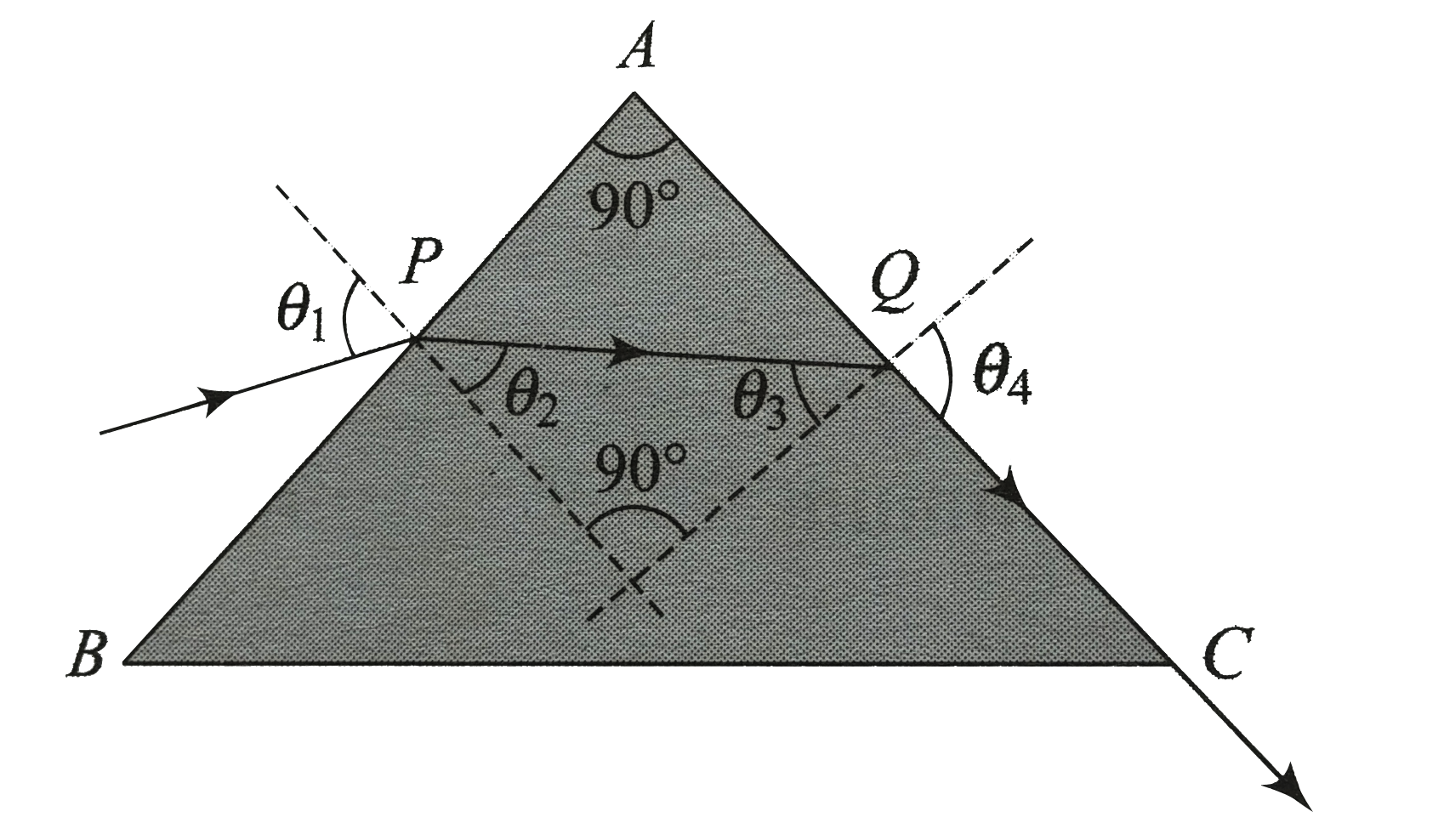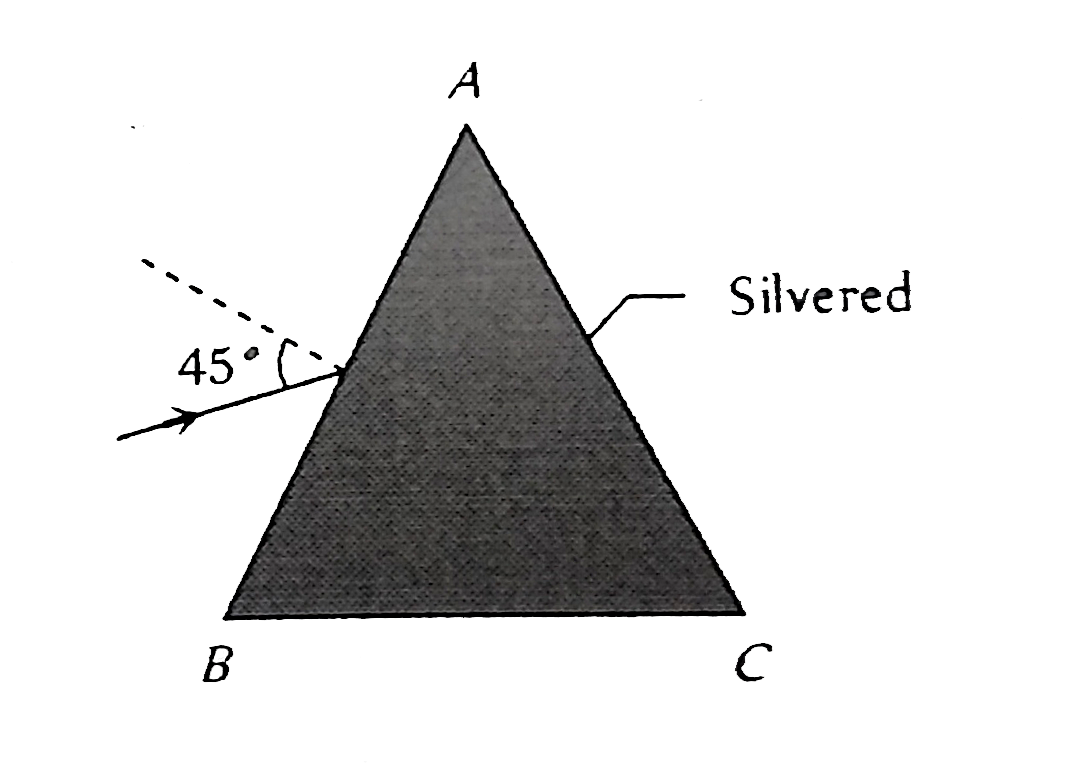Figure.. Shows a triangular prism of refracting angle 90∘ . A ray of light incident at face AB at an angle θ1, refracts at point Q with an angle of refraction 90∘.
a. What is the regractive index of the prism in terms of θ1?
b. What is the maximum value that the refractive inde can have?
c. What happens to the light at Q if the incident angle at Q is (i) increased slightly, and (ii) decrease slightly?

a. Let the ray be incident at an angle θ1 at the face AB. It refracts at an angle θ2 and is incident at an angle θ3 at the face AC. Finally, the ray comes out at an angle θ4=90∘.
From Fig. , the normal at faces AB and AB make an angle of 90∘ width each other, θ3=90∘−θ2
sinθ3=sin(90∘−θ2)=cosθ2=√1−sin2θ2 (i)
From Snell's law at face AC, nsinθ2=1
√1−sin2θ2=1 (ii)
Form Snell's law at face AB, 1sinθ1=nsinθ2
sinθ2=singθ1n (iii)
From Eqs. (ii) and (iii), we have
n√1−sin2θ1n2=1 (iv)
On squaring Eq. (iv) and solving for n, we get
n=√1+(sin2θ1)
b. The greatest possible value of sin2θ1 is 1, hence, the greates possible value of n is nmax=√2=1.41.
c. i. For a given n, if θ1 is increased the angle of refraction θ2 increases. As θ3=90∘−θ2 the angle θ decreases, i.e., the angle of incidence at face AC is less than the critical angle for total reflection, hence light light emerges into air.
ii. If the angle of incidence is decresed, the angle of refraction θ2 decreases. So, the angle θ3 increases. The angle of incidence at the second surface is greater than the critical angle, so light is reflected at Q.
Topper's Solved these Questions
- BOOK - CENGAGE PHYSICS ENGLISHCHAPTER - GEOMETRICAL OPTICSEXERCISE - Solved Examples15videos
GEOMETRICAL OPTICS
- BOOK - CENGAGE PHYSICS ENGLISHCHAPTER - GEOMETRICAL OPTICSEXERCISE - Exercise1.114videos
GEOMETRICAL OPTICS
- BOOK - CENGAGE PHYSICS ENGLISHCHAPTER - ELECTRON,PHONTS,PHOTOELECTRIC EFFECT & X-RAYSEXERCISE - dpp 3.315videos
ELECTRON,PHONTS,PHOTOELECTRIC EFFECT & X-RAYS
- BOOK - CENGAGE PHYSICS ENGLISHCHAPTER - HEATING EFFECT OF CURRENTEXERCISE - Thermal Power in Resistance Connected in Circuit27videos
HEATING EFFECT OF CURRENT
Similar Questions
The refractive index of a prism is 2. this prism can have a maximum refracting angle of
View SolutionOne face of a prism with a refrective angle of 30∘ is coated with silver. A ray of light incident on another face at an angle of 45∘ is refracted and reflected from the silver coated face and retraces its path. What is the refractive index of the prism?
View Solution
Knowledge Check
- Question 1 - Select One
A ray of light is incident at 60∘ on one face of a prism of angle 30∘ and the emergent ray makes 30∘ with the incident ray. The refractive index of the prism is
A1.732B1.414C1.5D1.33
One face of a prism with a refrective angle of 30∘ is coated with silver. A ray of light incident on another face at an angle of 45∘ is refracted and reflected from the silver coated face and retraces its path. What is the refractive index of the prism?
View SolutionA ray of light is incident at 60∘ on one face of a prism of angle 30∘ and the emergent ray makes 30∘ with the incident ray. The refractive index of the prism is
View SolutionA ray of light is incident on a prism whose refractive index is 1.52 at an angle of 40∘. If the angle of emergence is 60∘, calculate the angle of the prism.
View SolutionA prism ABC of angle 30∘ has its face AC silvered. A ray of light incident at an angle of 45∘ at the face AB retraces its path after refraction at face AB and reflection at face AC . The refractive index of the material of the prism is
 View Solution
View SolutionAt what angle should a ray of light be incident on the face of a prism of refracting angle 60∘ so that it just suffers total internal reflection at the other face ? The refractive index of the prism is 1.524.
View SolutionA ray of light is incident at 65∘ on one face of a prism of angle of 30∘ and the emergent ray makes 35∘ with the incident ray. The refractive index of the prism is:
View SolutionThe angle of incidance for an equilateral prism is 60∘. What should be the refractive index of prism so that the ray is parallel to the base inside the prism ?
View Solution

